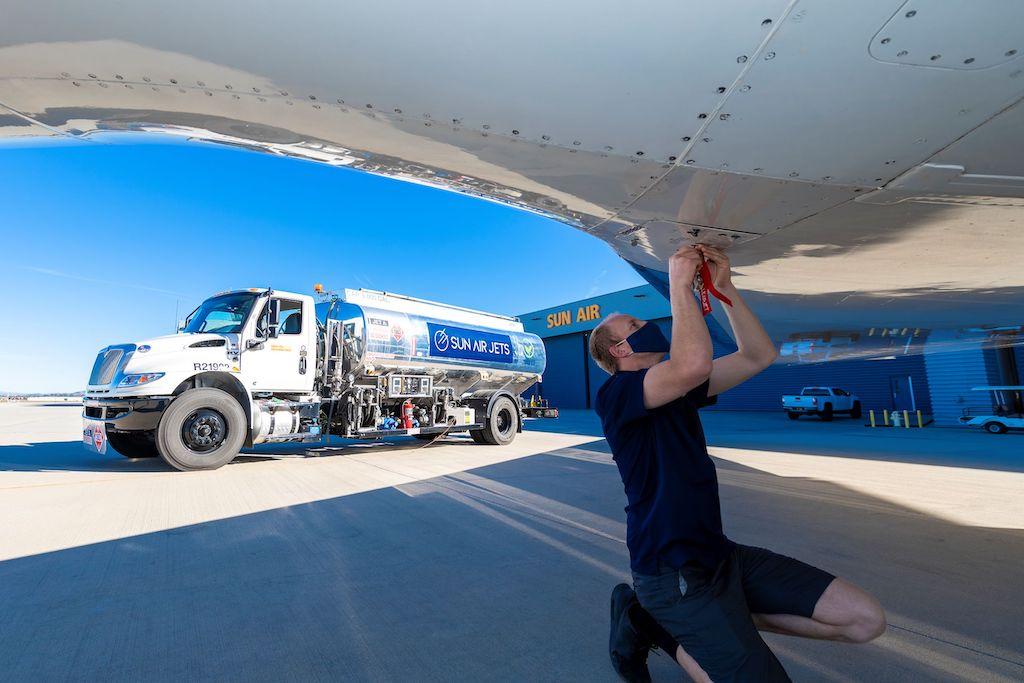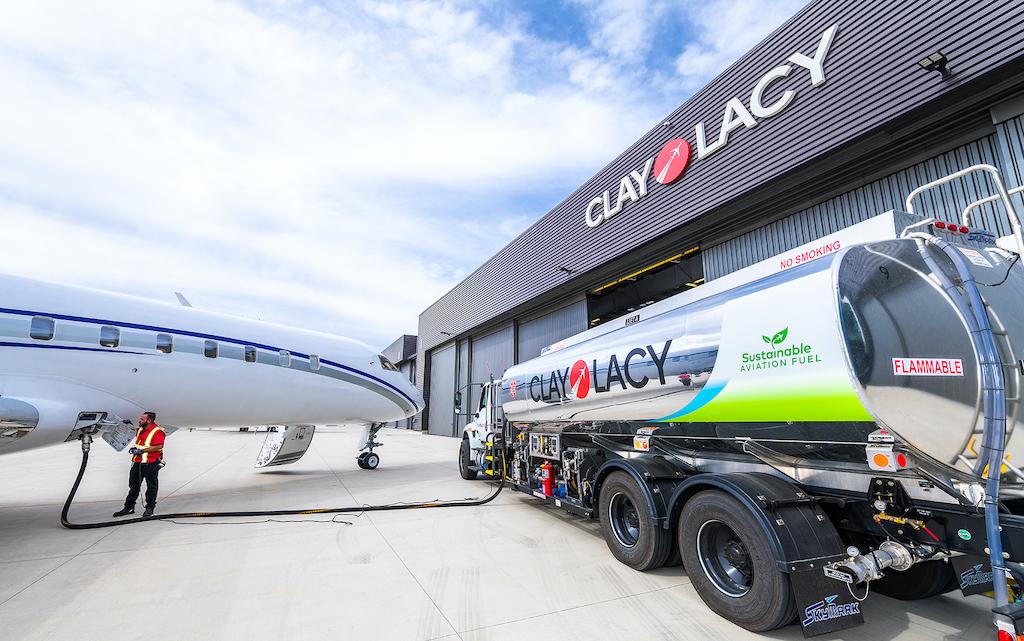
Editor’s Note: This is the second of two parts examining FBO sustainability initiatives, including Sustainable Aviation Fuel (SAF).
As of Jan. 25, there were 24 U.S. and eight European FBOs that either offered SAF or had announced they would offer it, according to 4AIR. The rating company’s interactive map of SAF locations serving business aviation (https://www.4air.aero/saf-map) shows them clustered in California, with other locations spread across the U.S. Aviation industry sources attribute the concentration of sites to California’s Low Carbon Fuel Standard (LCFS), an emissions-trading scheme that incentivizes the production and use of low-carbon transportation fuels, and physical proximity of SAF infrastructure.
In 2018, biofuel supplier World Energy acquired a former crude-oil refinery in Paramount, California, near Los Angeles. The company is investing a reported $350 million to convert the facility for commercial production of SAF, renewable diesel and renewable gasoline complying with the LCFS.
Avfuel Corp. of Ann Arbor, Michigan, and Finland-based Neste announced a distribution partnership in January 2021 that calls for Neste to provide a continuous supply of SAF “in volumes able to meet the growing demand” of Avfuel’s customers, including FBOs, airports and flight departments. Monterey Jet Center, an Avfuel-branded FBO in Monterey, California, was the launch customer. More recently, Ross Aviation said it accepted its first load of Neste MY SAF from Avfuel on Jan. 14 for its FBO at Jacqueline Cochran Regional Airport near Palm Springs, California. Ross plans to supply SAF at 18 other FBOs.
Neste said it will be able to produce 515 million gal. of SAF per year by the end of 2023, primarily at its facilities in Rotterdam, Netherlands, and Singapore.
“Neste is building an unparalleled, global SAF distribution network for business aviation with our partners Signature Flight Support, Avfuel, Jet Aviation and World Fuel Services,” the company said in response to a BCA inquiry. “Together, we have established a continuous supply of SAF to 14 FBOs in the U.S. and three FBOs in Europe, with more to come in both markets. Additionally, Neste is supplying SAF to leading commercial and cargo airlines at some of the world’s biggest airports, including at San Francisco International Airport.”
Still, more needs to be done to build out a nationwide SAF infrastructure, industry sources advise. “SAF certainly has challenges as it scales [ranging] from investment and production to cost and availability of feedstocks, along with new pathways and price parity,” NATA's Megan Eisenstein said.
“SAF is still limited in production,” she noted. “There is only so much supply to go around between various FBOs and corporate and airline customers. The investment in new production from current and new feedstocks will need to continue to grow in order to allow FBOs to scale up their SAF offerings. Another issue is the cost parity [with fossil-based Jet-A]. That’s a large component, and localized state incentives are likely to help concentrate much of that distribution into certain states and regions.”
The Green Attribute

To understand the business case for SAF, which currently costs about a dollar or more per gallon over conventional Jet A, it helps to separate the physical SAF product from the “green attribute,” Clay Lacy Aviation's Scott Cutshall said.
“The green attribute is how you as an end user, the person buying [the fuel], is able to claim an emission reduction in end-of-year reporting,” Cutshall explained. “What happens in reality at FBOs is the SAF goes into the tank, mixes with everything and we’re just pumping it. If somebody says they would like SAF, they pay the premium—it costs about a dollar more per gallon. On their invoice it says sustainable aviation fuel. If they need it, we can provide backup paperwork that describes the blend, the date of manufacture. When they go to do their end-of-year reporting of the total gallons of fuel bought, the SAF has a lower carbon footprint than the equal amount of Jet A, so they can claim the emission reduction.”
“In reality, that guy at my FBO that day may or may not have gotten the actual molecule to burn, because it might have been long-since pumped,” Cutshall added. “But I keep a book inventory of my SAF, of how much I can sell. Separating the green attribute from the molecule is the first thing everybody needs to get their heads around. If you don’t pay the premium for the green attribute, you can’t claim the reduction even though you may have burned the product.”
The concept of separating the physical product from its environmental benefit underpins FBO book-and-claim programs. Through book-and-claim, an operator flying from an airport that does not have SAF available can purchase—or book—a specific quantity from an FBO that does supply SAF, pay the premium and claim the emissions-reduction credit. The supplying FBO takes the green attribute off its books, and an equivalent amount of SAF is delivered elsewhere in the system.
Until SAF becomes widely available, business aviation is relying on book-and-claim to spur demand, Eisenstein said. Within the Business Aviation Coalition for Sustainable Aviation Fuel “we talk a lot about how book-and-claim can help build out this market,” she related. “The supply right now is primarily on the West Coast and that’s mainly due to California’s Low Carbon Fuel Standard, which is incentivizing the delivery there. Only aircraft based out there can physically uplift it. That’s why book-and-claim is a way to get it out into other places.”
Signature Flight Support, Avfuel and Jet Aviation launched book-and-claim programs in late 2021. Clay Lacy Aviation is not currently engaged in book-and-claim, said Cutshall, who argued that a centralized accounting system run by a third party or industry grouping is needed to manage the transactions.
“I think book-and-claim is what is available today for people who do not travel to locations where SAF is in physical supply, which is primarily the Western U.S.,” Cutshall said. “As more refineries come on line, I think book-and-claim will fade out over a long period of time because people want to take physical delivery [of SAF].”
Sustainable Aviation Facilities

Cutshall helped develop NATA’s Sustainability Standard for Aviation Businesses, and Clay Lacy Aviation was the first company to certify to the standard in December 2021. In January, Clay Lacy became the first company to receive 4AIR’s “Facilities Neutral” rating, validating its facilities have operated carbon neutral since 2019.
The NATA standard provides member companies with a self-certification process they can follow to reduce carbon-dioxide and other greenhouse-gas emissions in their operations. A first requirement for a company is to calculate its carbon footprint as a baseline for future comparison.
“A couple of FBOs that were part of the beta test process of the standard completely removed all plastic water bottles and only offer boxed water,” Eisenstein said. “Some folks have phased out plastic items such as straws and coffee stirrers—it can be little things. Some FBOs, not many, have installed solar panels, which is a huge investment. Some people have installed motion-sensor lighting in hangars.”
Clay Lacy has two FBOs, at Van Nuys Airport (KVNY) and John Wayne Orange County Airport in Southern California, and a third is planned to open at Waterbury-Oxford Airport, Connecticut, in 2023. Last year, the company installed a 500-kW solar array covering 30,000 sq. ft. of roof space at its headquarters, hangar and maintenance facilities at KVNY. The system generates 750,000 kW-hr. of electricity annually.
Through a partnership with Israel-based developer Eviation, Clay Lacy also plans to provide charging stations for Eviation’s nine-passenger Alice all-electric aircraft, scheduled to enter service in 2024.
Cutshall said the company is embracing sustainability now to preempt future regulations and demonstrate leadership within the industry. “The third reason is we felt it’s the right thing to do,” he added.
“I’m not saying convert all of your Jet A buying to 100% SAF tomorrow,” Cutshall said. “Start with small steps. Start with transitioning to LED lights; start with transitioning to installing low-flow water fixtures; start with measuring your [carbon] baseline. If everybody did that, the collective impact would be significant.”
FBOs Pump SAF And Launch Green Initiatives, Part 1:
https://aviationweek.com/business-aviation/airports-fbos-suppliers/fbos…


